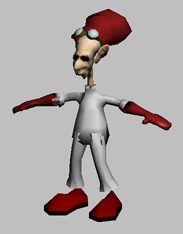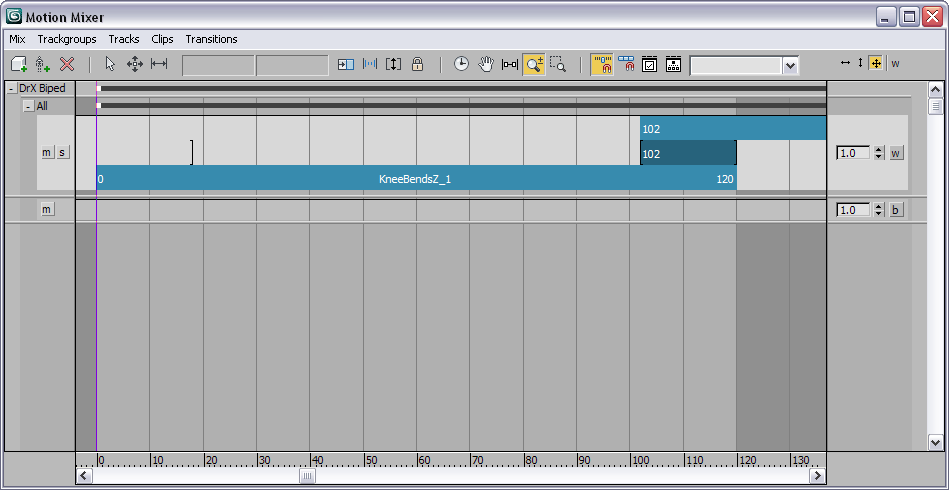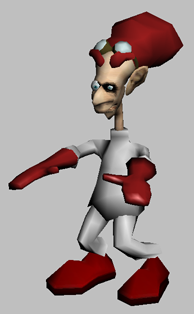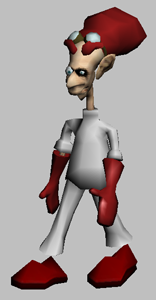In this lesson, you'll use the Motion Mixer with the two motion files you've just created. The Motion Mixer lets you create a smooth transition between Dr. X doing his deep knee bends and walking.
 open dr_x_03.max in the folder \character_animation\quick_start\.
open dr_x_03.max in the folder \character_animation\quick_start\.
This scene contains Dr. X ready for animation.

The Motion Mixer is like a sound mixer, except here you work with animation files instead of audio files. You'll add motion clips, which are .bip files, to the Motion Mixer, and create transitions between the clips to blend them smoothly together.
 Motion panel.
Motion panel.
 (Figure Mode) if it is on.
(Figure Mode) if it is on.
 (Mixer).
(Mixer).
3ds Max opens the Motion Mixer window.

The biped is automatically displayed in the Mixer. It has a default trackgroup labelled All, where you will start laying out your tracks, motion clips, and transitions. The label All indicates that motions placed on tracks will apply to the entire biped, rather than specific body parts.
Opening the Motion Mixer also automatically turns on the Mixer Mode button on the Biped rollout.

When Mixer Mode is on, the biped performs the motions in the Motion Mixer.
Trackgroups are populated by tracks, in the form of Layer tracks or Transition tracks. On each track, you add clips and transitions. The final product of your efforts is called a mix.
Here, you'll add two clips to the trackgroup with a transition between them.

By default, the topmost track is a layer track, which is designed for consecutive clips with no transitions between them. You want to create a transition between two clips, so you'll need a transition track.

The track is changed to a transition track that is taller than the original, with room for two tracks and a transition.
 From Files.
From Files.
The clip holding the knee-bend motion is added to the track.
 From
Files from the pop-up menu. Choose the file my_drxwalk.bip or dr_x_walk.bip.
From
Files from the pop-up menu. Choose the file my_drxwalk.bip or dr_x_walk.bip.
The second clip is added to the track, and a transition is automatically added between the two clips. The transition is colored with a darker version of the clip color, and spans the transition time between the two clips.

 (Zoom Extents) so you can
see the entire mix in the display.
(Zoom Extents) so you can
see the entire mix in the display.
 (Set Range).
(Set Range).
This feature automatically sets the length of the animation to the number of frames needed for the mix. In this case, it sets the animation length to 225 frames.

You've just created a basic mix comprised of two clips and a transition. Now you'll play the animation.
 (Mixer Mode) if it’s not
already on.
(Mixer Mode) if it’s not
already on.
 (Play Animation). Watch
the animation in the viewport and its progress in the Mixer window.
(Play Animation). Watch
the animation in the viewport and its progress in the Mixer window.
Dr. X does his knee bends in the first clip.

He smoothly transitions to walking in the second clip.

The feet slide a little during the transition. To correct this, you can right-click the parent, DrX Biped track, and from the pop-up menu choose Compute Mixdown. Mixing down the tracks preserves planted keys for the feet, so they no longer slide.
This tutorial introduced you to some of the essential components of character studio: creating a Biped system, using the Physique modifier to skin the Biped, animating the Biped in both freeform and footstep modes, and using the Motion Mixer to combine animated clips that have already been created.